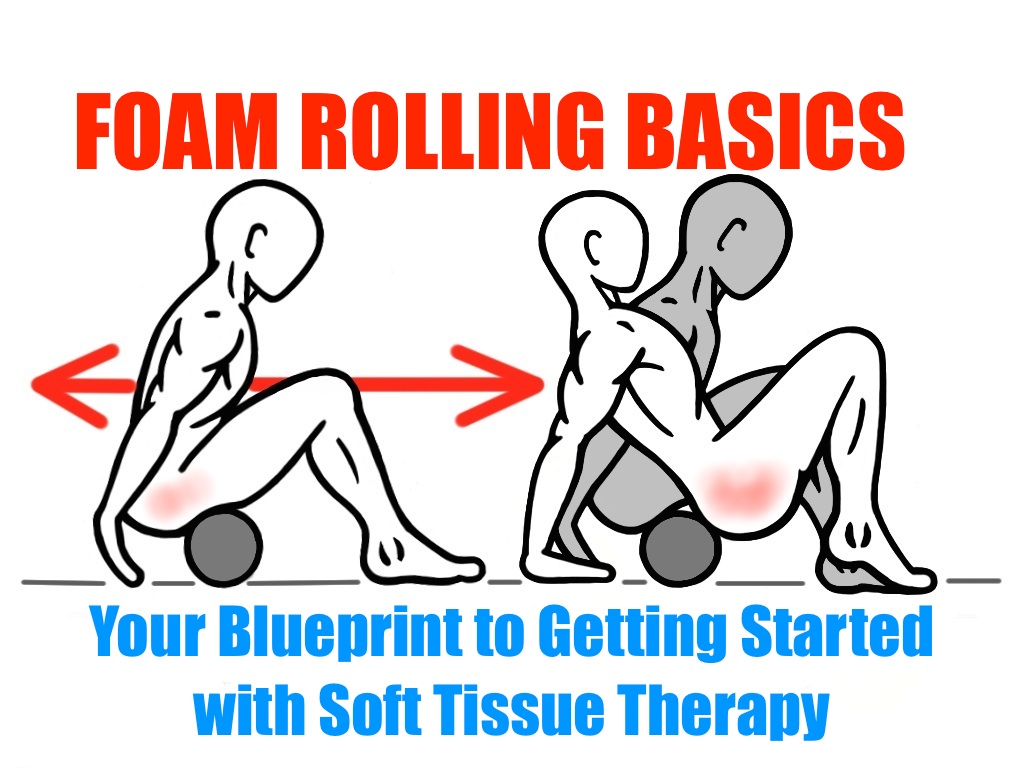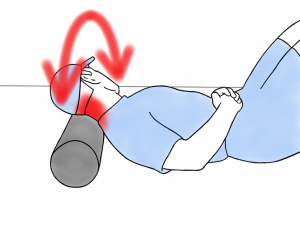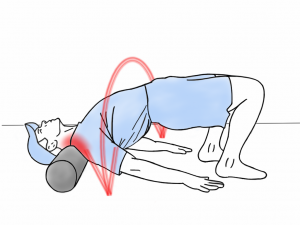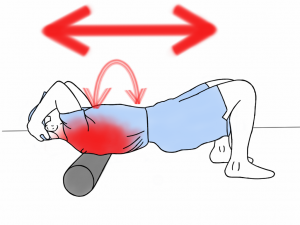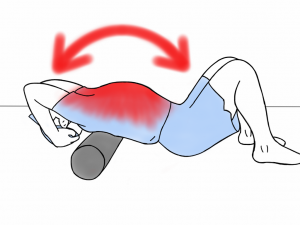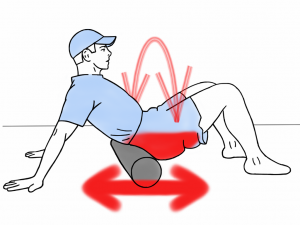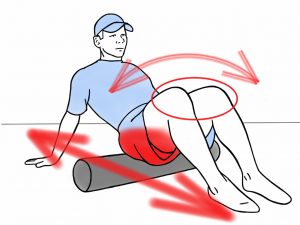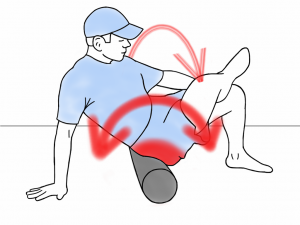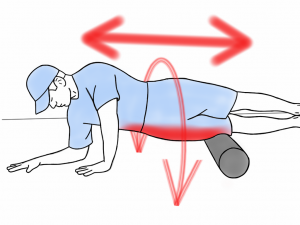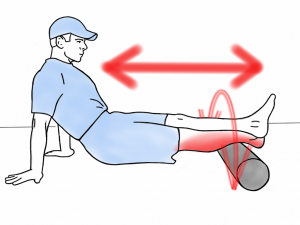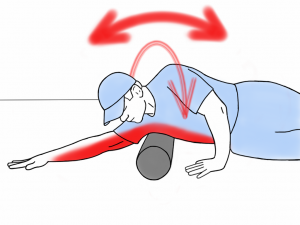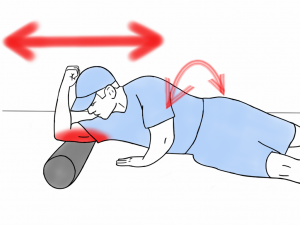The first time I foam rolled, I moaned in agony because it was so painful. I had spent my entire life playing sports, beating myself up, and creating a load of knots in my muscles and soft tissue. That first foam-rolling session made me realize my body was like a street full of speed bumps. Yet, when I placed my head on my pillow that night, I fell asleep in a heartbeat.
The very next day, I went right back to foam rolling, and I’ve used it repeatedly ever since. In fact, there have been nights where I have fallen asleep on my foam roller in my living room as I was massaging out the stressful knots in my body from a very long day.
Foam Rolling is a form of Soft Tissue Therapy and it is commonly referred to as a Self-Myofascial Release technique (SMR). It uses applied pressure to help break up knots and adhesions in the soft tissue as a way to restore functionality.
The benefits of foam rolling are tremendous. For athletes, foam rolling can provide the edge that can help you move quicker, reach further and recover faster. More specifically, foam rolling will help to:
Improve your Mobility
Activate Inhibited Muscles
Increase Neuromuscular Responses
You will be able to do more with less effort!
As mentioned before, foam rolling is a Soft Tissue Therapy technique and one of the easiest ones to learn. Below is a basic blueprint to get started with foam rolling.
Click here to read more about Soft Tissue Therapy Techniques.
Target Area: Neck
Place the back of your head on the foam roller as you lay on the ground. Gently press your neck into the roller as you slowly turn your head from side to side. Focus on applying pressure to the area where your skull connects to your neck. In this area of the neck there are a couple of small muscles that are responsible for moving your head. These muscles tend to hold a lot of tension, especially if you are habitually looking at a computer screen, driving a car, or just looking around the room. Furthermore, if you have a Forward Head alignment, where your ears vertically align in front of your hip sockets, the soft tissue in this target area will be experiencing an inappropriate amount of physiological stress on a daily basis.
Pain in the Neck
This is an example of a Forward Head alignment. Notice how the ears line up vertically in front of the hip sockets and create an elongated curve of the neck. This alignment stresses the back of the neck. Gently foam rolling this area can help reduce the tension in soft tissue and can help relive pain or discomfort.
Target Area: Trapezius & Shoulders
Place the tops of the shoulders on top of the foam roller where part of your Trapezius muscle is located, also known as your Trapz. Next, bridge your hips up in the air as far as you can to help create more pressure on the Trapz. Once you have created adequate pressure on the Trapz, start to slowly roll back and forth in small increments. Remember to breathe and relax.
While rolling back and forth, start to oscillate or rotate the torso in order to change the angle of pressure on the Trapz. You want to explore and search for tense areas or knots in your soft tissue. Once you find a sensitive area, practice gently rolling through and oscillating on top of that knot or adhesion until you can feel it release and smooth out.
Oscillate-
If you are unfamiliar with this technique or term, think of a room fan that turns from side to side. It’s oscillating. This is the motion that you will want to apply to your soft tissue in addition to just rolling over the target area. Oscillating will help to break up knots and adhesions more by emulating a massage technique known as Cross Fibering.
Note-
The higher you lift your hips, the more weight you can direct down onto your trapz, which will apply more pressure. This is a helpful cue because the Trapz get very tight and overworked in many people who do not have adequate shoulder stability. The Trapz can be especially exasperated in people who work at a desk, drive a lot and spend more time on developing their chest and shoulders with “Pushing” or “Pressing” exercises in the gym, such as a Bench Press or Military press.
The main goal is to smooth out and lengthen your Trapz as much as possible.
Target Area: Back & Thoracic Spine
Interlace the hands behind your head and squeeze your elbows towards each other. This position will spread your shoulder blades and allow you to foam roll the rest of your Trapezius muscle as well as your Rhombiods, Latissimiss (Lats) and Erector Spinae muscles, which collectively span over your rib cage, spine and shoulder blades.
Roll over the entire back of the rib cage and shoulders while oscillating or rotating in order to help break-up the tightness that may exist between the individual ribs and vertebras as well as around each shoulder blade. If you come across an area that is too painful or sensitive to roll over, gently roll the tissue in the surrounding vicinty instead as you breath deeply and relax.
Essentially, you are treating all of the muscles that are responsible for your upper body’s alignment and posture as well as mobility and stability of the shoulders and arms. On average, these muscles have a tendency of being under-developed, turned-off and sticky due to repetitive lifestyle factors of desk work, driving and too much emphasis on “pushing exercises” in the gym, such as bench pressing and push-ups.
Trigger Points-
Somewhere in your soft tissue, you come across specific spots of high neuromuscular activity, which may radiate pain and discomfort. These are Trigger Points and they become sensitive due to a high frequency of tension in the area because of repetitive movement. In other words, these trigger points are neuromuscular junctions that are over worked and physiologically over stressed.
Treating Trigger Points is extremely important to restore functionality back to the area in terms of mobility and strength. However, the damage to these areas may already be very severe. If this is the case, it is wise to apply soft tissue therapy techniques, such as foam rolling, to the tissue in the surrounding area in a combination with other restorative techniques, such as stretching, mindful relaxation and sleep.
Target Area: Chest, Shoulders & Thoracic Spine
Place the foam roller under your heart and set your hips flat on the ground as you interlace your hands and support your head. Reach the top of your head back towards the floor as you keep the hips on the ground.
Use the foam roller as a fulcrum to bend your Thoracic Spine over and open up the front of your rib cage. Breathe deeply and release all tension from your body as you lengthen the spine.
Keep the back of your neck long and pull the belly button into the spine to engage the abdominals. This helps maintain the natural alignment of the Lumbar Spine- the vertebrae that connect your rib cage to your pelvis. It is common for people to bend or manipulate the Lumbar Spine as a way to compensate for a lack of mobility in the Thoracic Spine. Avoid this compensation by activating your abdominals.
Gently oscillate or rotate the rib cage in this exercise and re-position the foam roller under another part of the Thoracic Spine. This will shift the fulcrum and change the angle of flexion in the spine and rib cage.
Also, use this exercise in combination with other soft tissue therapy techniques that you can apply to the chest and shoulders.
Target Area: Hips
Sit and gently roll over the top of the foam roller. You want to cover the entire area of the hips, from the top of the pelvis to all the way under the “Sit Bones” or where your hamstrings and thighs connect to the pelvis.
When rolling over the hips, slowly turn the knees towards one side to rotate the angle of the hips on the roller. Incrementally changing the position of knees will help apply pressure to different areas of the hip’s soft tissue, which increases the effectiveness of this technique.
Prime Movers-
The hips, and more specifically the Gluteus Maximus, Gluteus Medius and Gluteus Minimus, are the true engines of the body. These muscles are primarily responsible for creating all locomotive forces, ie walking, running, squatting, jumping and so forth.
Applying soft tissue therapy techniques to the hips will only enhance your ability to perform any movement with more power and strength as well as help the body maintain proper alignment while moving.
Red Flag or Compensation-
People who have sedentary lifestyles are at a higher risk for having the Glutes become Inhibited or “Turned Off” because of the lack of frequency in use of these muscles. In other words, the axiom of “use it or lose it” is fittingly appropriate.
Foam rolling over the hips will help to create more neuromuscular responsiveness in the hips and help to activate the Glutes before exercising or competing.
Target Area: Piriformis
Deep within the hip socket is the Piriformis muscle also known as the walking muscle. This is a small muscle that connects the Femur (thigh bone) to the Pelvis and initiates hip extension or the backwards stride phrase when you walk and run.
Sit on the roller and place one ankle on top of the opposite knee. Then rotate the hips slightly on an angle while rolling back and forth. Your body is angled towards the side that has the foot off of the ground. You should feel the roller pressing into the soft tissue deep within the hip, near the actual hip socket.
Target Area: Lateral Side of the Hips & Legs
Lie on top of the foam roller and turn your hips 90 degrees onto their sides. Slowly roll down the side of your body from your hips down to your knees while gently oscillating or rotating along the way.
You will be applying pressure to the Vastus Lateralis, a muscle on the outside of your thighs, as well as to the Iliotibial Band, commonly referred to as your IT Band. Both of these soft tissue structures will get over-worked and stressed due to instability and the lack of mobility in the corresponding hip and ankle. Therefore, it’s important to include more exercises in your PreHab routines for Hip and Ankle stability and mobility if this area of your body is very sensitive or experiences discomfort while foam rolling.
Target Area: Quadriceps and Hip Flexors
Lie on top of the foam roller with your hips facing the floor. Slowly roll over the front of your thighs and the hips while gently oscillating or rotating along the way.
You will be foam rolling your Quadriceps and Hip Flexor muscles, which both tend to be tight and inflamed in people with sedentary lifestyles as well as for those that wear high heels. The Quads and the Hip Flexors will commonly be over-worked and stressed as they attempt to compensate for the lack of Glute activation in many activities including running and lunging.
Re-Train Compensation Strategies
Foam rolling the Quadriceps and Hip Flexors will help to lengthen these tissues and restore proper range of motion. The improved mobility of the hips will help you to activate the Glutes and re-train the way that you run, squat and lunge.
If you experience sensitivity or discomfort in this area while foam rolling, include other mobility techniques, such as the Couch Stretch or Kneeling Hip Flexor Stretch with a combination of activation exercises for the Glutes.
Target Area: Calves
Place one leg on top of the foam roller just behind the knee. Start to roll down towards the ankle as you gently oscillate or rotate your legs.
Use your arms to lift your hips off the ground to create more pressure on the calves while rolling. You can also use the top leg to squeeze the bottom calf into the roller if you keep your hips on the floor.
Articulate the Ankle
You can help to break up more of the knots and adhesions in your calves by slowly pointing and flexing the foot as you foam roll. The articulation of the ankle joint will combine with the applied pressure of foam rolling to help release more of the stickiness in this area.
Target Area: Lats & Shoulders
Lay an arm over the foam roller and slowly roll the sides of body where your Latissimus muscles are located. Oscillate or rotate the rib cage as you roll up into your armpit and over the backs of your shoulders.
There are a couple of muscles, the Teres Major and Teres Minor that connect your arm to your shoulder blade. As part of a compensation strategy, these muscles will become over-worked and stressed in people who do not have adequate shoulder and scapula stability.
It is very beneficial to foam roll this area in your PreHab routine with a combination of shoulder/scapula stability exercises, in particular Scapula Retraction and Scapula Depression.
Target Area: Arms
Lay your arm over top of the foam roller and gently oscillate or rotate the arm as you roll back and forth. You can also articulate the elbow joint by bending and extending your arm to help create more release within the soft tissue of the arm.
It’s important to foam roll the arms as well as the rest of the body because the soft tissue will experience the formation of knots and adhesions in it especially for those who workout with weights or play throwing sports.
Navigating through Soft Tissue Therapy
The purpose of foam rolling, as well as all soft tissue therapy techniques, is to prepare the body to move by breaking up knots and adhesions that cause restrictions on our movement. These techniques will help to restore the full range of motion in joints and muscles while ultimately improving mobility. Foam rolling offers a way to treat our soft tissue in broad strokes while also including some fine details.
How to Approach Foam Rolling
Since it’s possible to address the entire body in as little as 10 minutes, foam rolling is a great place to start. It’s also a form of therapy that can help you learn more about your soft tissue and movement tendencies. Here’s how to maximize the effect of foam rolling:
•Foam Roll the entire body with as much fluidity and speed as possible.
•Combine other mobility techniques to the areas in which you experience any discomfort or sensitivity.
For example, include passive stretching and mindful relaxation for the shoulders and neck if you experience pain or tension in these areas.
•Coordinate corresponding Activation and Stability exercises for your trouble areas.
For example, combine exercises to activate the glutes when experiencing tightness and sensitivity in the Quads and Hip Flexors.
Feel the Difference.
It’s important that you actually feel a difference after you have foam rolled as a way of knowing that you are improving the functionality of your soft tissue. If you do not notice an improvement in how you move and how you feel, then it is best to switch to a different kind of technique to help prepare you to move.
If you are new to soft tissue therapy, foam rolling is the perfect place to start! And don’t worry, the more that you practice, the better you will get at foam rolling and the more results you will see in how you train and exercise!
To understand more about Soft Tissue Therapy – CLICK HERE
